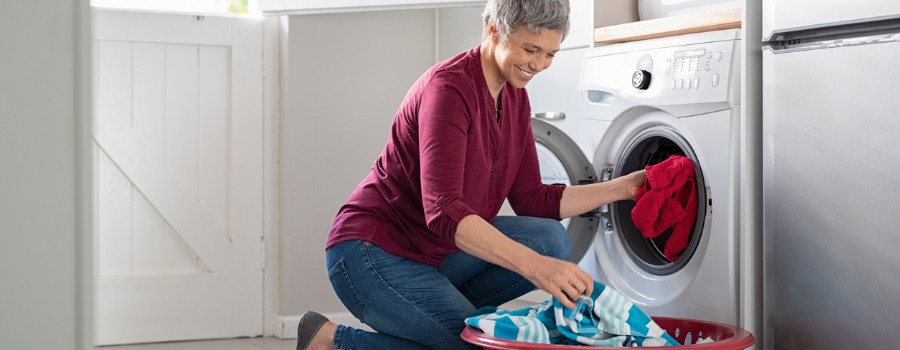If you’re like 80% of American households you have a dryer somewhere at home that is used almost every time a load of laundry is washed. As you move damp clothes and towels from the washer to the dryer you may briefly wonder how much electricity each load costs you. How costly is the luxury of getting clothes dry without a line?
The dryer accounts for a good chunk of the overall electricity use in a home despite being a single-purpose machine that isn’t in use the majority of the time like a refrigerator. When the EPA looked at various household appliances, the clothes dryer was the biggest energy hog.
Annual Electricity Use
Clothes Dryer – 769 kWh
Clothes Washer – 590 kWh
Dishwasher – 206 kWh
Refrigerator – 596 kWh
That’s right. The average clothes dryer uses more electricity than the average refrigerator. But the amount of electricity used by one dryer isn’t going to be the same as another – even if they are the same exact models.
When calculating electricity use, it’s not always straightforward. You have to factor in a number of variables that can increase or decrease how much electricity a clothes dryer consumes.
6 Things That Influence Dryer Electricity Use
Many energy factors are at play when the dryer is running. Below are six factors that have the biggest influence on dryer electricity use.
Age of the Dryer
As with most machines and devices, the older a dryer gets the less efficient it becomes. The majority of clothes dryers that are in use are between 2-9 years old.
The wattage of the Dryer
Dryers are typically somewhere in the range of 2,000 to 6,000 watts. What that means is a dryer uses between 2 and 6 kilowatts an hour.
ENERGY STAR Certification
Is your clothes dryer ENERGY STAR certified? If so, it should use around 20% less electricity compared to a standard machine. The EPA notes that these energy-efficient dryers have electricity-saving features like advanced moisture sensors that minimize run-time.
Dryer Time of Use
If you have a time-of-use plan and you time it right, technically you can run the dryer without using any electricity – at least you won’t be charged for it anyway. Some people who are serious about minimizing electricity costs will wait until the free period (usually after midnight) to dry their clothes.
While you can avoid the electric charge your dryer is still using electricity. The time of day won’t affect how much electricity is used.
Dryer Settings
The settings on your dryer can be used to make energy use as efficient as possible. Generally, a low heat setting that runs for longer will use less electricity than a high heat setting for a shorter amount of time. Using the cool down cycle setting is another way to use less electricity by utilizing the warm air inside the machine. Also, always use sensor drying rather than a timed dry if it’s an option.
Load Sizes
You may have heard that it’s best practice to fully load a dishwasher before running it to maximize efficiency. Well, the same is true for the clothes dryer. The dryer should be full but not too full. It takes longer to dry clothes when the dryer is overloaded or the load is too small.
What’s in the load can also make a difference. It’s recommended to dry towels and heavy clothes separate from lighter clothes because combining them will extend the drying time.
How to Calculate the Cost of Running Your Dryer
Now that you have a better idea of what affects your dryer’s electricity use, let’s take a look at how to calculate how much energy it consumes.
Get the Dryer’s Wattage
As long as you know your clothes dryer’s wattage you can run the numbers to get a rough estimate of kWh use. (If you don’t know the wattage look for it on the UL label.)
Clock the Drying Time
Time a few loads of laundry to see about how long it takes to dry each one. This should give you an idea of how long drying time is on average per load.
Convert the Drying Time Length to a Percentage
To calculate the kilowatt-hours you need to convert the drying time to a percentage of an hour. Let’s say you have a really efficient dryer that dries a load in 30 minutes. That would be 0.5 or 50% of an hour.
Multiply the Drying Time Percentage With Wattage
Now for the math. You’re going to first multiply the drying time percentage with the machine’s wattage. For this example, we’ll assume the clothes dryer wattage is 4,000 watts.
0.5 X 4,000 = 2,000 watts
Divide by 1,000
From here you can convert watts into kilowatt-hours by dividing the total by 1,000 (there are 1,000 watts in 1 kilowatt-hour).
2,000 watts / 1,000 = 2 kilowatt-hours
In this example, the clothes dryer uses 2 kilowatt-hours per load. If you know your kWh rate you can also determine the approximate cost to dry each load by multiplying the kilowatt-hours by the price per kWh. See what kWh rates are currently available through Major Energy. We strive to supply electricity plans with reliable, fixed rates that make it easier to estimate the monthly costs before your bill arrives. Make electricity costs more predictable with Major Energy!
